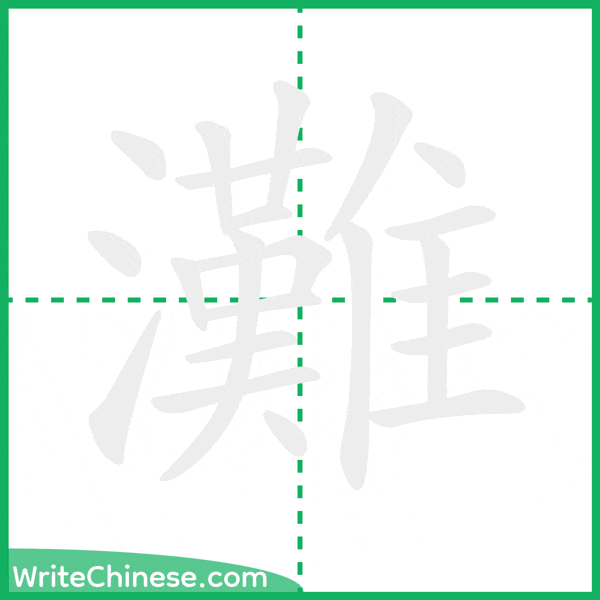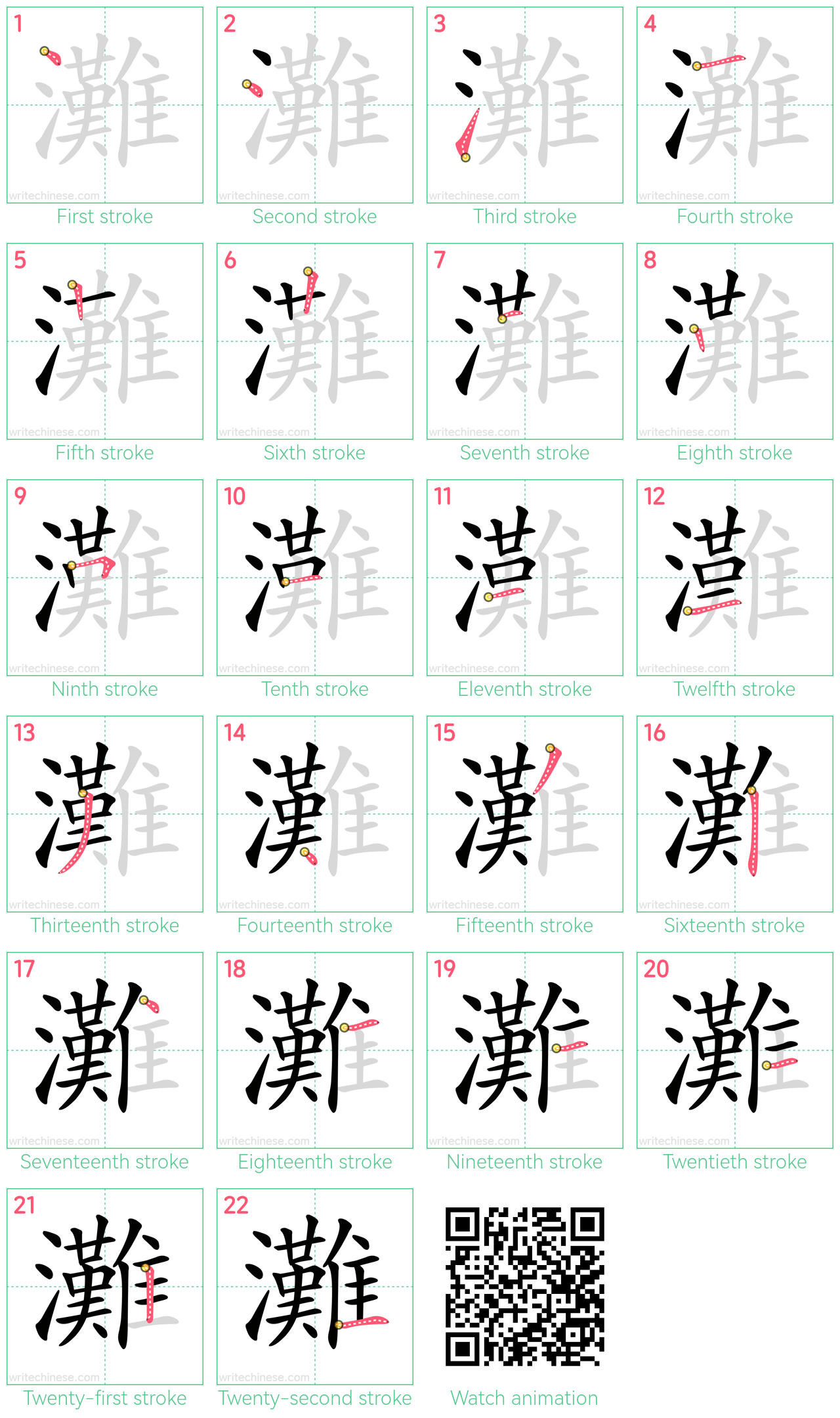How to write 灘
Animated Stroke Order of 灘
Learn to write the Chinese character "灘" by watching the stroke order animation of "灘".

Stroke by Stroke: 灘 Writing Order
Master the Chinese character '灘' stroke by stroke with visual step-by-step instructions.

Follow the Calligraphy Master: Writing '灘' Step-by-Step
Learn the proper way to write the Chinese character '灘' through a video tutorial with a calligraphy teacher. Follow the Calligraphy Master's Step-by-Step Guide to Write the Chinese Character '灘'. You can download the printable handwriting worksheets below and practice writing together with pen and paper.
Free Printable 灘 Handwriting Practice Worksheets
Meaning of 灘
Same Pronunciation Characters
Same Radical Characters
- 汁
- 汇
- 汉
- 汗
- 汛
- 汝
- 江
- 池
- 污
- 汤
- 汪
- 汰
- 汹
- 汽
- 沁
- 沃
- 沈
- 沉
- 沐
- 沙
- 沛
- 沟
- 没
- 沥
- 沦
- 沧
- 沪
- 沫
- 沮
- 河
- 沸
- 油
- 治
- 沼
- 沽
- 沾
- 沿
- 泄
- 泊
- 泌
- 法
- 泛
- 泞
- 泡
- 波
- 泣
- 泥
- 注
- 泪
- 泳
- 泻
- 泼
- 泽
- 洁
- 洋
- 洒
- 洗
- 洛
- 洞
- 津
- 洪
- 洲
- 活
- 洼
- 洽
- 派
- 流
- 浅
- 浇
- 浈
- 浊
- 测
- 济
- 浏
- 浑
- 浓
- 浙
- 浦
- 浩
- 浪
- 浮
- 浴
- 海
- 浸
- 涂
- 消
- 涉
- 涌
- 涕
- 涛
- 涝
- 涡
- 涣
- 涤
- 润
- 涧
- 涨
- 涩
- 涮
- 涯
- 液
- 涵
- 淀
- 淆
- 淋
- 淌
- 淑
- 淘
- 淡
- 淤
- 淫
- 淮
- 深
- 淳
- 混
- 淹
- 添
- 清
- 渊
- 渐
- 渔
- 渗
- 渝
- 渠
- 渡
- 渣
- 渤
- 温
- 港
- 渲
- 渴
- 游
- 渺
- 湃
- 湖
- 湘
- 湾
- 湿
- 溃
- 溅
- 溉
- 源
- 溜
- 溢
- 溪
- 溯
- 溶
- 溺
- 滇
- 滋
- 滑
- 滔
- 滚
- 滞
- 满
- 滤
- 滥
- 滨
- 滩
- 滴
- 漂
- 漆
- 漏
- 漓
- 演
- 漠
- 漫
- 漱
- 漾
- 潇
- 潘
- 潜
- 潭
- 潮
- 澄
- 澈
- 澎
- 澜
- 澡
- 澳
- 激
- 濒
- 瀑
- 灌
- 汀
- 汊
- 汐
- 汔
- 汕
- 汜
- 汨
- 汩
- 汲
- 汴
- 汶
- 汾
- 沂
- 沅
- 沆
- 沌
- 沏
- 沔
- 沣
- 沤
- 沩
- 沭
- 沱
- 泅
- 泐
- 泓
- 泔
- 泖
- 泗
- 泠
- 泫
- 泮
- 泯
- 泱
- 泷
- 泸
- 泺
- 泾
- 洄
- 洇
- 洌
- 洎
- 洙
- 洧
- 洫
- 洮
- 洱
- 洳
- 洵
- 洹
- 浃
- 浍
- 浒
- 浔
- 浚
- 浜
- 浞
- 浠
- 浣
- 浯
- 涅
- 涎
- 涑
- 涓
- 涔
- 涞
- 涟
- 涠
- 涪
- 涫
- 涸
- 涿
- 淄
- 淅
- 淇
- 淖
- 淙
- 淝
- 淞
- 淠
- 淦
- 淬
- 渌
- 渍
- 渎
- 渑
- 渚
- 渥
- 渫
- 渭
- 湄
- 湉
- 湍
- 湎
- 湔
- 湛
- 湟
- 湫
- 湮
- 溆
- 溏
- 溘
- 溟
- 溥
- 溧
- 溱
- 溲
- 溴
- 溷
- 溻
- 溽
- 滁
- 滂
- 滏
- 滓
- 滗


